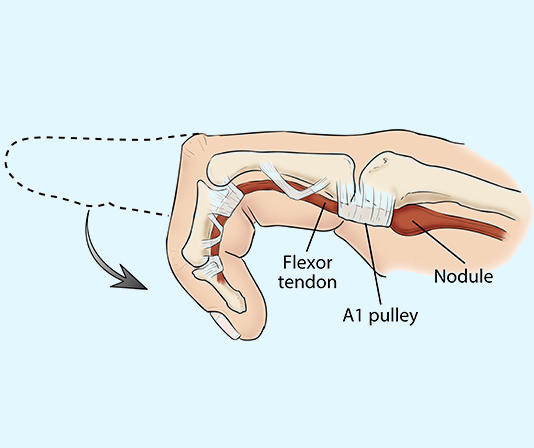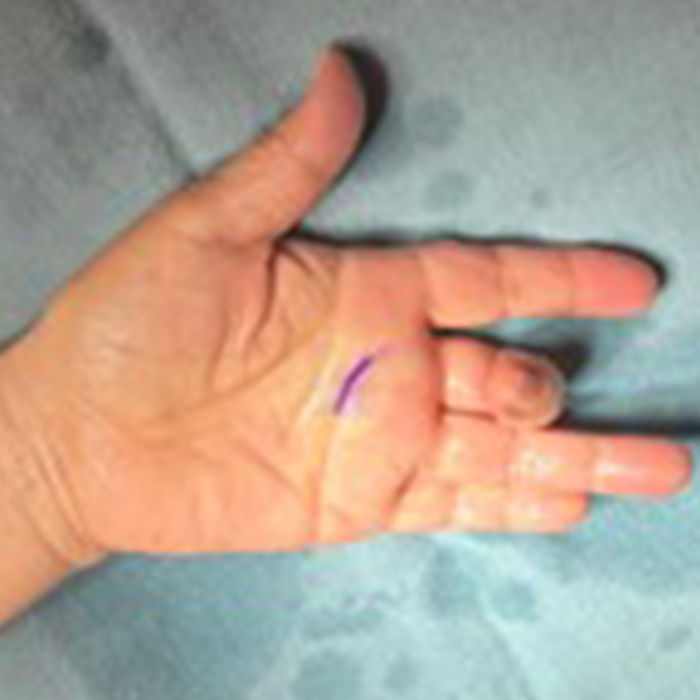Trigger Finger
What is it?
Trigger Finger is a condition where the affected finger(s) snap or get locked in a bent position due to inflammation or scarring of the flexor tendons in the hand. The triggering is due to the affected tendon getting caught on the A1 pulley which is a band of tissue located where the finger meets the palm. As a result, the tendon is unable to move properly and may cause pain and stiffness.

Trigger Finger
What are the symptoms?
Patients typically experience a “snapping” or “locking” motion of any of the affected fingers when you attempt to open or close your hand. This is typically worst in the morning when you first wake up. Sometimes, a small lump, called a nodule, can be felt in the hand and can be tender or painful to touch.

What is the cause?
Trigger finger is caused by repetitive trauma to the affected finger. This may include activities that require repetitive/prolonged gripping or straining of the hand such as sports, knitting, typing on a keyboard, and playing an instrument. In addition, people with inflammatory conditions such as rheumatoid arthritis and diabetes, or previous injury to the hand are also more likely to develop a trigger finger.
How is it treated?
- Conservative Management: Options include rest and avoidance of activities that irritate the finger, wearing a splint to keep the affected finger straight, and/or physical therapy.
- Injection Therapy: The use of corticosteroid injections to decrease inflammation and pain of the tendon sheath is the first-line treatment choice. Reducing inflammation will open up the narrowed tunnel that the tendons pass through, allowing it to move freely again. A second injection may be given 6 weeks after the initial injection if the trigger does not resolve.
- Surgical Management: Surgery is considered typically as a last resort if symptoms persist after 2 to 3 injections. The tendon sheath of the affect finger(s) will be opened up to free the trapped tendon.
During surgery
- This is a day surgery, meaning that you are not admitted to stay overnight.
- There is no fasting required for this surgery.
- Please let your surgeon know if you are taking blood thinners. Some patients who are on blood thinners may need to pause their medications.
- First, your incision site will be numbed using local anesthesia which is the most painful part. The surgery itself should not feel painful, however you may feel some pushing and pulling just like you do at the dentist.
- Right before the surgery begins, a tight cuff will be placed on your upper arm to constrict blood flow. The cuff will be inflated for approximately 5 to 10 minutes and may cause some discomfort.
- A small incision will be made to allow the surgeon to release the trapped tendon. The location of the incision depends on the affected finger(s) but is located on the palm of the hand. Once the tendon is released, the incision will be sutured closed and wrapped with dressings.
After surgery management
What to expect
- You should not experience much pain after the procedure. If you experience pain, you may take over-the-counter Tylenol Extra Strength (Acetaminophen) or Advil (Ibuprofen) for pain relief. If you are experiencing severe pain, please contact your physician or go to the emergency room.
How to manage your wound
- For at least 2 days after the surgery, keep the dressing clean, dry, and intact.
- After 48 hours, you may remove the dressing and tensors (elastic bandage).
- After removal, wash the wound(s) with soap and water at least 3 times a day, and expose it to air to allow it to dry. Apply a thin layer of Polysporin to the incision site.
- You should have a follow-up appointment booked for 10 to 14 days after the procedure for your doctor to assess the wound and remove the sutures.
- Please note that a bit of swelling over the incision is normal. However, watch out for signs of infection such as redness that spreads beyond your incision(s), skin breaking open, and/or pus draining from the incision(s).
- If you experience any of these signs of infection, please call your surgeon to book an appointment as soon as possible or go to the emergency room.
Exercises for recovery
- Use of your hand immediately after surgery is encouraged to prevent scarring.
- However, avoid heavy lifting or strenuous activity until the sutures are removed at your follow-up appointment.
- Feeling hardness over the incision site after surgery is normal as it is a result of scar tissue development. After your stitches are removed, you should massage the area 3-4 times a day to help heal the skin and help with the sensitivity that develops with non-use. Over time, the hardness should go away.